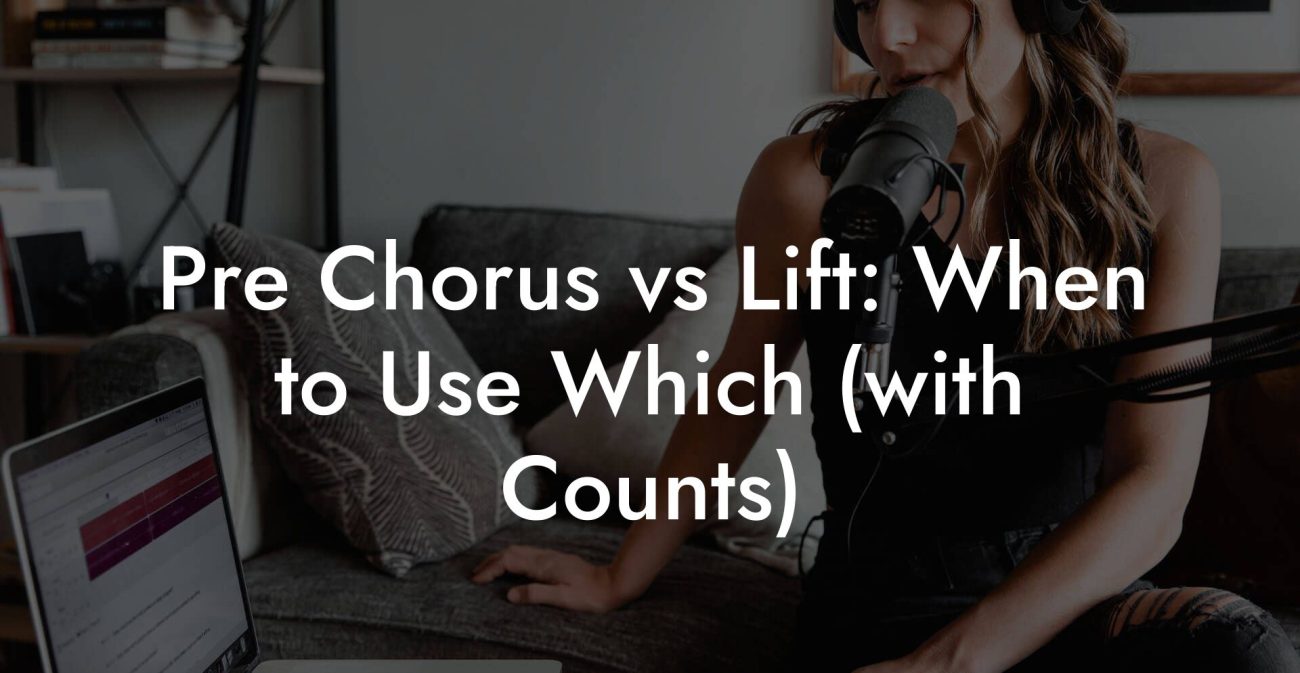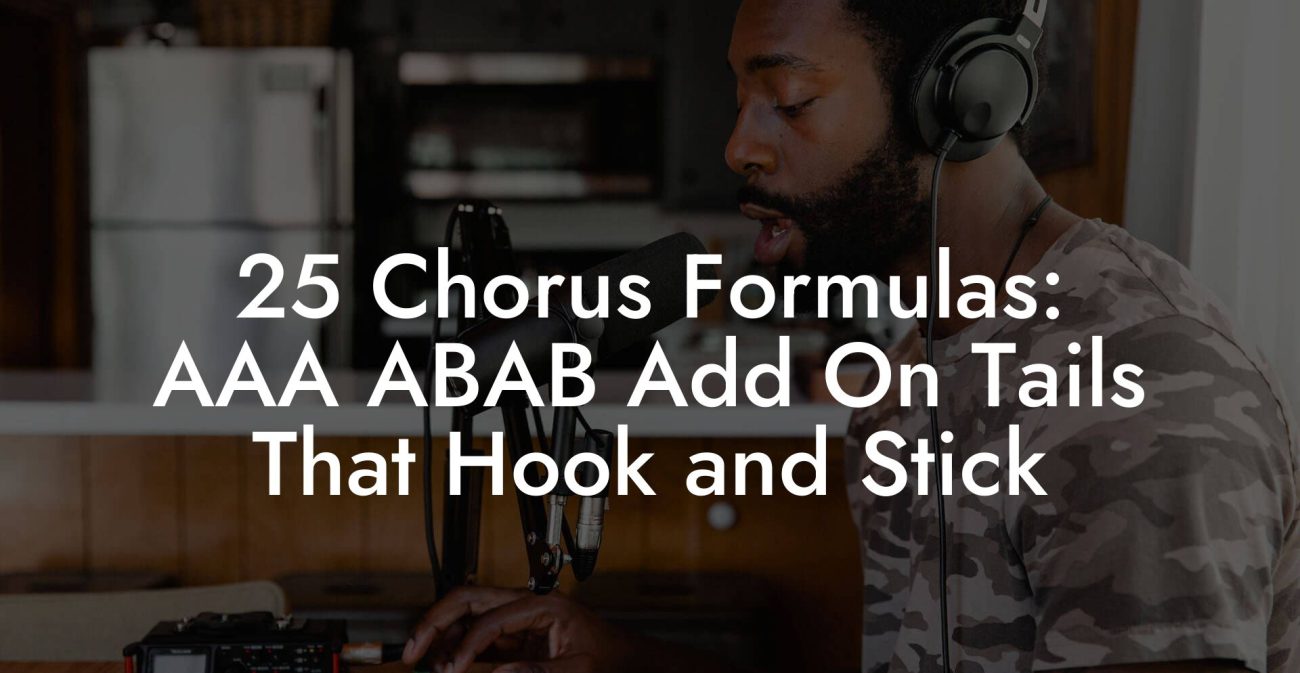Songwriting Advice
Counter Melodies and Ad Libs That Don’t Crowd the Lead

You want a hook that punches and extras that flatter. Counter melodies and ad libs can turn a good hook into a memorable moment. They can also make your chorus sound like three people shouting different songs at the same time. This guide teaches you how to write and place counter melodies and ad libs so they lift the lead vocal. You will get simple rules, creative prompts, mixing moves, live performance hacks, and real life scenarios you can steal for your next session. Everything is written for busy artists who want results and a little chaos that actually helps.
Quick Interruption: Ever wondered how huge artists end up fighting for their own songs? The answer is in the fine print. Learn the lines that protect you. Own your masters. Keep royalties. Keep playing shows without moving back in with Mom. Find out more →
Quick Links to Useful Sections
- What We Mean by Counter Melody and Ad Lib
- Why Artists Use Counter Melodies and Ad Libs
- Principles that Keep Extras from Stealing Focus
- Rule 1: Respect the Lead
- Rule 2: Give Each Line a Job
- Rule 3: Carve Frequency Space
- Rule 4: Leave Gaps
- Rule 5: Respect Rhythm
- Writing Counter Melodies That Support the Hook
- Method: The Answer and the Echo
- Harmonic considerations
- Motivic development
- Ad Libs That Add Charm Without Sabotage
- Types of ad libs
- Ad lib placement cheat sheet
- Real Life Scenarios
- Scenario 1: The Bedroom Demo
- Scenario 2: Live Band Rehearsal
- Scenario 3: TikTok Hook
- Mixing Moves to Keep Extras from Crowding the Lead
- Step 1: High pass everything that does not need low end
- Step 2: Carve the mid range
- Step 3: Use stereo placement
- Step 4: Automate levels
- Step 5: Use delay and reverb like a position marker
- Step 6: Parallel processing for glue
- Step 7: Sidechain ducking if needed
- Arrangement Tricks to Preserve Focus
- Melodic Techniques for Clean Counter Lines
- Interval selection
- Rhythmic placement
- Motif variation
- Vocal Production Tips
- Common Mistakes and How to Fix Them
- Mistake: Overwriting everything
- Mistake: Unfocused ad libs across the whole chorus
- Mistake: Ad libs fighting the lead frequency
- Mistake: Counter melody duplicates the lead melody
- Creative Exercises to Train Your Ear and Voice
- The Three Note Rule
- The Silent Beat Drill
- The Swap Test
- Live Performance Tips
- Notation and Communication Tips for Writers and Producers
- Examples You Can Model
- Example A: Minimal Pop Chorus
- Example B: RnB Glow
- Example C: Indie Rock Climax
- When to Remove an Extra Part
- Tools and Plugins that Help
- Checklist for Final Pass
- Next Level Ideas
- Ready to Try This Today
- FAQ
If you have ever been in a session where the producer says the background is too loud and you are thinking why does my own song sound like a crowd, this article is for you. We will cover musical role, spacing, frequency, timing, stereo placement, dynamics, melody craft, lyrical choices, and the secret sauce that makes an ad lib feel like a wink instead of a takeover.
What We Mean by Counter Melody and Ad Lib
First definitions so you and your crew speak the same language. A counter melody is a secondary melodic line that runs at the same time as the main melody. It can be sung or played by an instrument. It often moves in a different contour than the lead vocal. The goal is to create interest and support the main idea without confusing it.
An ad lib is a short improvised vocal phrase or sound that appears around the main vocal. Ad libs are usually smaller than a full verse or chorus line. They can be words, syllables, breaths, little riffs, or background shouts. Ad libs add personality and texture. When done well they feel spontaneous. When done badly they feel like someone forgot to leave the room.
Both tools are seasoning not main course. Think of the lead vocal as the steak. Counter melodies and ad libs are the chimichurri and a squeeze of lime. They enhance the steak without turning the dinner into a salad party.
Why Artists Use Counter Melodies and Ad Libs
- Create contrast so repeated choruses still feel new.
- Fill space in gaps where the lead breathes or rests.
- Reinforce theme by echoing or answering the title phrase.
- Build hooks where a small tag becomes the earworm.
- Give performers moments to show personality without rewriting the song.
Principles that Keep Extras from Stealing Focus
Follow these rules like a curfew on a wild night. They work in the studio and on stage.
Rule 1: Respect the Lead
The lead vocal carries the song story. If the listener cannot sing back the title after one chorus, you failed. Counter melodies and ad libs exist to push the listener toward that title not away from it. Always ask, does this make the title clearer or more muddled.
Rule 2: Give Each Line a Job
Every musical part should have a clear role. Roles include anchor, response, color, rhythm, and surprise. Write the role before you write the notes. If a counter melody is trying to be the anchor and the lead is also trying to be the anchor the result will be tired and confusing.
Rule 3: Carve Frequency Space
If the lead occupies mid range and breathy presence, place counter melodies above or below that. Use EQ to roll off competing mid frequencies on the extra parts. A simple rule is low, mid, high. If the lead sits across 1.5 kilohertz to 4 kilohertz, let the counter live around 400 hertz for warmth or above 6 kilohertz for sparkle. We will get technical in the mixing section. For now picture voices in a room. If everyone stands in the middle you cannot tell who said what.
Rule 4: Leave Gaps
Silence is a tool. Do not fill every beat. Place an ad lib on the offbeat or in the tail of a phrase. A well timed little riff in the last half of a bar can feel like a secret handshake. When everything sings at once the listener hears mush. When a tiny voice appears after a breath the listener celebrates the arrival.
Rule 5: Respect Rhythm
Use rhythmic contrast. If the lead is syncopated and busy, keep counter melodies long and sustained. If the lead is static and held, give the counter a rhythmic motive. Rhythm separation makes the ear sort parts faster than pitch separation alone.
Writing Counter Melodies That Support the Hook
Start with the lead. Record a clean pass of the vocal and listen for anchor points. Anchor points are where the melody lands on the title, the emotional phrase, or a long note. Mark those moments. Your counter melody should avoid landing on the exact same anchor unless you are deliberately stacking for power with careful EQ.
Method: The Answer and the Echo
- Record the lead vocal phrase you want to support.
- Sing or play a scale over it and mark the notes that feel like an answer not a copy.
- Write a phrase that responds to the lead in meaning or musical direction. Shorter lines work better as answers.
- Test in single track. If the two melodies fight, simplify the counter by removing passing notes or lowering the range.
Example practice exercise: sing your chorus line. Now sing a second line that only uses three notes that are not the chorus top note. Keep saying the second line until it feels supportive. That is your counter melody seed.
Harmonic considerations
Counter melodies work best when they imply harmony without clashing. Start with consonant intervals. Consonant intervals are intervals that sound stable to most listeners. These include thirds, sixths, perfect fifths, and octaves. If you want a hint of tension use a second or a seventh and resolve it quickly to a consonant interval.
Practical rule: when the lead sings the tonic or the main chord tone, let the counter choose a chord tone that complements rather than duplicates. If the chord is C major and the lead sings E, consider a G or C in the counter. If you use a non chord tone it should create a melodic intention like a passing tone or a suspension that resolves.
Motivic development
Make the counter melody repeatable. Give it a small motif of two to four notes and vary the ending over repetitions. This makes the counter a character not background noise. Great pop counter melodies have a recognizable rhythm shape that the listener can hum under their breath while the lead is busy being vulnerable.
Ad Libs That Add Charm Without Sabotage
Ad libs live in the emotional margins. They are best used as punctuation. Think of them as a wink or a foot tap. Keep them short and strategic.
Types of ad libs
- Echoes which repeat a word or phrase from the lead in a simplified form.
- Riffs which are short melodic runs that decorate sustained notes.
- Fillers which occupy a space between phrases and maintain energy.
- Atmospherics which are non lexical sounds like hums, breaths, whispers, or shouts that add texture.
Ad lib placement cheat sheet
- Add echoes under the lead when you want to hype the phrase.
- Use riffs on long held notes where the lead holds a vowel.
- Drop in a filler before a chorus to ramp energy.
- Use whispers or breaths in intimate verses to increase closeness.
Pro tip: record three different ad libs of the same moment. Pick one for the first chorus, another for the second, and then combine them layered on the final chorus. This keeps repetition interesting.
Real Life Scenarios
Scenario 1: The Bedroom Demo
You are writing a chorus in your bedroom with your phone recording. You want extras but you do not have a crew. Sing a single note harmony above the chorus on the second and fourth bars only. That small lift humanizes the chorus without adding new lyrics. Later in the studio record that same line with tighter timing and a brighter EQ to make space for the lead.
Scenario 2: Live Band Rehearsal
Your band has a backing singer but the mix is rough. Teach the backing singer a one bar response that sits behind the lead and is sung one octave lower. If their tone is raw that rawness can add emotion without stealing the clarity of the singer. On the recording you can smooth the tone. Live you embrace the grit.
Scenario 3: TikTok Hook
You need a 15 second loop that hops into the feed. Record an ad lib tag that repeats a single word from the chorus in an unexpected register. Keep it on the last beat. Viewers will try to double it and that creates shareable content. Keep the ad lib short and bold.
Mixing Moves to Keep Extras from Crowding the Lead
Mixing is where chemistry becomes clarity. The creative choices you made while writing can be refined with EQ, panning, level, dynamics, and effects.
Step 1: High pass everything that does not need low end
Use a high pass filter on counter melodies and ad libs to remove rumble and low mud. For voices you can often set the high pass between 120 hertz and 300 hertz depending on the timbre. This removes bass energy that competes with the chest of the lead vocal. The lead retains the body and presence while extras get air and color.
Step 2: Carve the mid range
Find the most important frequency range of the lead. For many modern pop vocals this is around 1.5 kilohertz to 4 kilohertz. Use a narrow cut on the ad libs around 2 kilohertz if they are clashing. Alternatively you can boost the counter in a higher region like 6 kilohertz to give shimmer. EQ is a conversation not a fight. Cut to create space, boost to highlight personality.
Step 3: Use stereo placement
Place counter melodies slightly off center. Keep the lead dead center. Even a 20 percent pan will create separation in the brain. For ad libs that want presence use a subtle stereo spread and delay the left and right channels by a few milliseconds to widen without making them louder.
Step 4: Automate levels
Compression can make an ad lib overpowering. Instead of crushing it with a heavy compressor use volume automation to drop the ad lib at intense moments and raise it when the lead leaves space. Automation is your friend. It gives the part movement and keeps the lead in charge.
Step 5: Use delay and reverb like a position marker
Give the lead a closer, drier room. Put counter melodies and ad libs on longer reverb tails or more pronounced delay. That pushes them back in perceived space. For example send the lead to a short plate reverb and the ad lib to a warm hall with a low mix. The ear hears depth and prioritizes the dry signal. A small early reflection on the ad lib can also help it read as separate without being distant.
Step 6: Parallel processing for glue
Send the ad libs to a parallel bus with gentle saturation and glue compression. Blend the processed signal under the dry ad libs to add weight without increasing competition. This trick gives fullness to the extra parts while keeping the lead vocal clear.
Step 7: Sidechain ducking if needed
If the counter melody frequency range sits squarely in the lead range, use a very subtle sidechain where the ad lib bus ducks a hair when the lead sings. Make the attack super fast and the release musical so the ducking is felt not heard. This is a surgical way to keep presence without removing character.
Arrangement Tricks to Preserve Focus
Arrangement choices are as important as mixing. Think about where you place counter melodies and ad libs across the song form.
- Use call and response sparingly. A single call and the lead answers. It is satisfying and clear.
- Reserve the busiest textures for the final chorus. Gradual accumulation creates payoff.
- Pull back in verse two to let lyrical detail breathe. Let the chorus be the moment extras move forward.
- Use space in intros so the listener recognizes the lead when it arrives.
Melodic Techniques for Clean Counter Lines
Interval selection
Use lower thirds and perfect fifths for harmony style counters. Use seconds and sevenths for tension that resolves. Use wide leaps only when the lead is static and needs a lift. Prefer stepwise motion with an occasional leap to create interest.
Rhythmic placement
Let the counter breathe on weaker beats or the offbeat. If the lead lands on downbeats avoid placing major melodic events on the same downbeat. That keeps the lead's arrival clean. If the lead stretches a note across two bars, a rhythmically active counter can dance around that held note and create motion.
Motif variation
Repeat a small motif and vary one element each chorus. That small change keeps the listener engaged and prevents overcrowding because the change signals intention.
Vocal Production Tips
When recording counter melodies and ad libs follow these vocal tips so the takes are usable and friendly to mix.
- Record several passes with different dynamics. Keep one laid back and one forward. You can choose later.
- Record a dry take and a processed take. Dry is essential for flexibility. Processed takes add character for demos and quick mixes.
- Use different vocalists for texture. Even slight timbral difference creates natural separation without EQ surgery.
- Consider doubling the counter at a lower octave instead of an exact unison. That creates depth.
Common Mistakes and How to Fix Them
Everyone has been there. Here are the usual crimes and surgical solutions.
Mistake: Overwriting everything
Fix: Remove an instrument or ad lib. If the moment survives the cut it was not essential to begin with. Less is a force multiplier.
Mistake: Unfocused ad libs across the whole chorus
Fix: Pick one place in the chorus for a single memorable tag. Let the rest breathe. Repetition creates memory more reliably than clutter.
Mistake: Ad libs fighting the lead frequency
Fix: EQ the ad libs and lower their level. Try boosting the ad libs at a high frequency instead of mid range. Use stereo placement to separate them from the lead.
Mistake: Counter melody duplicates the lead melody
Fix: Change either the rhythm or one or two notes so the pattern reads as support not a copy. A counter that is too similar becomes noise.
Creative Exercises to Train Your Ear and Voice
The Three Note Rule
Write a counter melody that uses only three notes over the chorus. Record it and mix it under the lead. If it feels supportive you can expand it. This constraint forces you to find a motif that works without stealing the top line.
The Silent Beat Drill
Pull the lead vocal out of the mix. Leave the instrumental and the counter. Sing the lead melody with your mouth muted. Listen to how the counter frames the phrase. This reveals collisions you might not notice when everything is loud.
The Swap Test
Swap the lead and the counter parts and listen. If the swapped version is better you either wrote the wrong lead or you made the counter too strong. Either way you get useful data.
Live Performance Tips
Live contexts require quick decisions. Use these rules on stage so the live energy does not collapse into chaos.
- Keep the lead central in the PA. Backing parts should be slightly behind.
- Use in ear monitors to tame how loud the band feels. Performers often push when they cannot hear the lead accurately.
- Teach backing singers their exact moments. Rehearse the silence as much as the notes. Silence is part of arrangement.
- If you have looping pedals use the loop for a textural counter not a full melodic lair. Looping the counter can anchor the song but do not loop the lead.
Notation and Communication Tips for Writers and Producers
When you hand off counter parts to other musicians communicate clearly. Use simple shorthand that your session players understand.
- Label parts anchor, response, color, or hype so the player knows the intention.
- Write intervals instead of exact notes if you want freedom. For example write third above vocal instead of exact pitch for singers to adapt to their range.
- Record a scratch guide track that demonstrates dynamics and timing. Nothing communicates intention like hearing a human sing it.
Examples You Can Model
Short examples you can try in your DAW or on your guitar.
Example A: Minimal Pop Chorus
Main hook: I will not call tonight
Counter: hum on a fifth above the chorus on bars two and four only. Add a small airy breath on the last syllable of each chorus line. Mix the hum at 40 percent and high pass at 300 hertz. Result: a lift that does not compete.
Example B: RnB Glow
Main hook: You keep me on slow
Counter: a three note motif that echoes the last word on the offbeat. Add a short delay on the counter with 180 millisecond left and right slight detune. Result: a woozy reply that sits behind the lead.
Example C: Indie Rock Climax
Main hook: We are lighting up the night sky
Counter: a harmonized line a third below in the last chorus only. Compress the counter bus with gentle attack so the transients sit behind the lead. Pan the harmonies left and right and keep the lead center. Result: a stadium feeling without losing lyrics.
When to Remove an Extra Part
Ask these questions. If you answer yes to any two remove the part.
- Does it mask the lead lyric on first listen?
- Does it repeat information without adding a new angle?
- Does it make the chorus length feel longer not richer?
Editing is an act of empathy for the listener. You take away what the listener does not need. That restraint gives the song impact.
Tools and Plugins that Help
Here are practical tools and why they matter. I will explain terms like you are trading beats on a couch not taking an audio engineering exam.
- EQ or equalizer. This tool cuts or boosts frequencies. Use it to carve space for parts.
- Deesser a compressor that reduces harsh sibilant sounds like s and sh. Useful for bright ad libs that spike.
- Delay echo effects. Use simple slap back delays to add rhythm without clouding clarity.
- Reverb creates depth. Use short reverbs to keep parts intimate and long reverbs to push them back.
- Saturation mild harmonic distortion that makes a voice sound bigger without raising level.
- Stereo imager widens or narrows a part. Use it to spread ad libs while keeping the lead focused.
- DAW means digital audio workstation. This is your recording software like Logic, Ableton, Pro Tools, or FL Studio. It is where you assemble, edit, and mix.
Checklist for Final Pass
- Solo the lead and listen for lyric clarity.
- Bring in counter melody. Check for collisions on anchor syllables.
- Use high pass on the counter and ad libs. Adjust EQ so lead presence remains clear.
- Place counter slightly off center in the stereo field.
- Automate ad libs so they do not compete in the chorus peaks.
- Test on small speakers and headphones to catch masking you missed on studio monitors.
- Play the song for two people who do not know it. Ask what line stuck. If they cannot name the title or the hook you have work to do.
Next Level Ideas
Once you master the basics you can experiment with counter melodies that comment on the lyric. For example write a counter that sings the opposite point of view in the background for a subtle narrative twist. Think of the counter as a character in a movie. The main character is in the foreground telling the story. The other character reacts in five seconds. That reaction can be supporting, snarky, or tragic depending on your intent.
Another idea is to automate subtle pitch modulation on ad libs so they shimmer in a way that the ear reads as movement not pitch war. Use this sparingly. Too much modulation feels like a party trick.
Ready to Try This Today
- Pick a chorus and record a clean lead vocal.
- Sing three different counter motifs as short takes. Keep them under four seconds each.
- Choose the one that feels supportive. High pass it at 250 hertz and pan it 20 percent left or right.
- Record three ad libs for the final chorus. Keep each ad lib to one breath or one word.
- Mix the ad libs 6 decibels lower than the lead initially. Adjust for emotional moments only.
- Play the song on two different playback systems and ask which lines they remember. Iterate two times and stop. You are done.
FAQ
What is a counter melody?
A counter melody is a secondary melodic line that plays or sings simultaneously with the main melody. It supports and creates interest without replacing the lead.
How loud should ad libs be relative to the lead?
Start about six to ten decibels lower than the lead and adjust. Use automation so ad libs can peak higher on quiet parts and drop during intense lead moments.
Should counter melodies always harmonize?
No. They can harmonize, respond, or provide rhythmic contrast. The most important goal is to avoid confusing the listener about the main lyric.
Can instruments have counter melodies?
Yes. Guitars, synths, strings, and horns often carry counter melodies. The same rules apply. Carve frequency and space and keep the instrument role clear.
How do I notate counter melodies for session musicians?
Write the intention like answer or color. Provide a simple score with rhythm and starting and ending notes. Record a guide vocal to show dynamics and timing.
Is layering many ad libs ever a good idea?
Yes in the final chorus if done with purpose. Build layers gradually and keep each layer complementary. Too many similar layers at full level will smear clarity.




